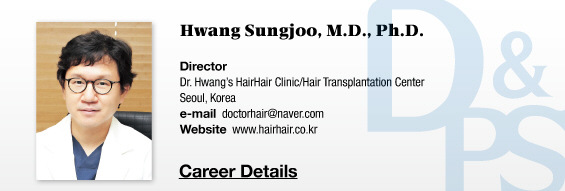Unlike other plastic surgeries that shows immediate outcome in several days or weeks, transplanted hair starts to grow again 3-5 months after going through temporary loss of the hair, and it takes about a year until the maximum aesthetic effect can be achieved, requiring patience from both patients and doctors. This means that complications are also delayed compared to other procedures. As reflected in the fact that hair transplantation takes the lead among medical suits in association with aesthetic surgeries, complications occur not infrequently after hair transplantation. It is important to be well informed of the hair transplantation procedures that may yield good results and methods to prevent possible complications. Complications after hair transplantation can be divided to either medical or aesthetic. I will summarize here the complications on the donor site and recipient site, treatments and preventions.
[Ad. ▶Ultra Skin/Pastelle - Manufacturer: WONTECH(www.wtlaser.com)]
Complications on the Donor Site
1. Medical complications
1) Necrosis and Wound Dehiscence
When the donor site dissection is wide enough to preclude suture, the inability to suture or very tight suture may cause blood circulation insufficienct, resulting in complications, such as tissue necrosis or parted suture (Figure 1).


Figure 1. High suture tension may cause tissue necrosis.
In order to prevent such outcome, the donor site should be resected within a proper range, typically about 1-1.5cm. For example, if the scalp moves well when pulled up and down, suture is easily applied to 1.5cm dissection. If the scalp is too tight and does not move well, it may be awkward to suture even 1cm dissection. When it is difficult to perform donor site closure, it is more recommended to suture just enough to not cause a tension and then make the wound recover by secondary intention. Since necrotic tissue often leaves excessive scar, it is more important to prevent necrosis in advance.
2) Pain, hypoesthesia, hyperesthesia and neuralgia
Perioperative pain or preoperative anxiety of pain can be reduced with the use of adequate anesthesia and tranquilizer. Most patients feel strong pain from the donor site after hair transplantation, which can be treated effectively by Tylenol. However, Tylenol alone might not be sufficient when the patient is very sensitive to pain, in which case other analgesics can be additionally used. The pain tends to be reduced a lot by 2 days after the procedure in most cases. The scalp may have reduced sensation or paresthesia at the donor site or the upper side of the donor site, which is typically relieved in several months but may continue for more than 1-2 years in rare cases. Patients may complain serious neuralgia like electric stimulation, which can be explained by neural injury during the donor site dissection or abnormal healing process of the nerve. Suture-site injection of corticosteroid and bupivacaine may be helpful for reducing such neuralgia symptom. For the prevention of neuralgia, it is recommended to perform the dissection at the level of subcutaneous fat layer and suture the dissection without tension to minimize neural injury.
3) Hemorrhage
Donor site hemorrhage after hair transplantation is very rare but may occur in among heavy drinkers, patients with hypertension, and those who had taken drugs that may interfere with hemostasis, such as aspirin and vitamin E. Such drugs should be discontinued at least 1-2 weeks before the procedure, and the blood pressure should be adequately controlled. Care should be taken because peripheral hemorrhage may continue when the height of wound edge is not well adjusted during suture.
4) Infection
Infection after hair transplantation is very rare but is a possibility among patients with immunodeficiency due to diabetes, cirrhosis and other disease. Since there have been reports of MRSA infection in rare cases, the surgical instruments should be thoroughly sterilized and care should be taken to prevent infection.
2. Aesthetic complications
1) Donor site scar, hypertrophic scar and keloid

Figure 2. Scar tends to occur more frequently after excessive dissection or in younger people.
The trend in scar differs among different races and age groups; Asian people tend to have scar more frequently than Western people, and the size tends to be bigger among young adults in their 20-30s than adults in their mid-40s or above, possibly because the former has more active wound healing process (Figure 2).
In order to minimize scar, the width of dissection at the donor site should be minimized and trichophytic suture can be combined as well. Care should be taken among patients with physical tendency to develop hypertrophic scar or keloid. As for the treatment, hair transplantation at the scarred area and scar removal by W-plasty can be helpful, and suture after simple dissection is known as not effective.
2) Loss of existing hair from donor site
Hair loss may occur at the proximal and distal area of the suture from 2 weeks after the procedure. It is speculated to be caused by temporary blood circulation insufficiency and is relieved in 3-6 months in most cases (Figure 3).

Figure 3.Temporary hair loss may occur after harvesting hair from donor site.
Too much tension should not be applied to suture. As lying on bed for a long time during the transplantation may cause ischemia due to the pressure from the pillow, it is recommended to take a rest halfway through the procedure so that ischemia could be prevented.
Recipient Site Complications
1. Medical complications
1) Scalp pruritus
Mild to severe pruritus of the recipient site is a common symptom, and may develop as a secondary symptom of neural injury, crust, folliculitis and seborrheic dermatitis. Mild symptom can be managed by topical steroid application, but serious symptom may require the administration of anti-histamines.
2) Facial edema
Post-operative facial edema is a common complication, which can last for at least 3-6 days, once developed, causing interference with social life (Figure 4). After injecting dozens of cc of anesthesia solution and inflicting thousands of needle injury to the recipient site, the hair follicle transplanted in the skin may cause inflammatory reaction, increasing extracellular fluid, and the excessive lymph flows down to the forehead and eyelid, making the face swollen. In order to prevent this, triamcinolone can be mixed with the anesthesia solution for the recipient site or oral administration of prednisolone may be also helpful. Facial edema can also be prevented by maintaining supine or lateral decubitus position for about 24-48 hours after the procedure so that the lymph can be drained to the back of the head.

Figure 4. Facial edema occurs frequently after hair transplantation and may cause interference with social life
3) Folliculitis
Various patterns of inflammatory lesions from mild to severe folliculitis may occur when the hair follicle is transplanted deeper than the appropriate depth (Figure 5). Transplantation to a proper follicle depth is most important for prevention. Increased sebum secretion and inappropriate scalp washing than usual may lead to secondary folliculitis. It can be prevented by washing hair with appropriate manner, and application of topical steroid is helpful for relieving the symptom. Combination with oral antibiotics may be helpful for severe cases.

Figure 5. Follicle transplantation deeper than an appropriate depth may cause folliculitis
4) Cyst
When the hair follicle is transplanted deeper than an appropriate depth, the hair may not grow and form a cyst inside the dermis, causing continuous inflammation. Removing the cyst by Incision and Drainage (I&D) is the only option for the treatment. The best prevention is transplantation to an appropriate depth depending on the length of follicle.
5) Hemorrhage
Patients with existing hypertension or increased blood pressure due to perioperative tension may experience hemorrhage during the transplantation at the recipient site. Since hemorrhage causes difficulty in the process of graft placement, proper blood pressure control is a necessity. Post-operative hemorrhage at the recipient site is very rare. Care should be taken for patients with existing hemorrhagic disease. Drugs that may prevent hemostasis (warfarin, aspirin, coumadin, etc.) or dietary supplements that may delay hemostasis, including vitamin E, omega-3, red jinseng juice, garlic juice and onion juice should be discontinued at least 1-2 weeks before the procedure.
2. Aesthetical complications
1) Unnatural hairline
The hair transplantation is a failure if the hairline looks Unnatural and artificial (Figure 6). As I have mentioned in the previous chapter about natural hairline, unnatural hairline becomes apparent when 2 or 3 hair strands are transplanted along the hairline or when the hairline was made in a straight line. Correction by reoperation is available, but the best preventive method is to make a zigzag line using a single hair strand at the first procedure.

Figure 6. Transplantation with multi-hair follicular unit or in straight line leads to unnatural outcome
2) Low survival rate and hair loss afterward
The average survival rate of transplanted hair is about 90%, but the hair may not grow at all in very rare cases, no matter how experienced the doctor was. Survival rate may be reduced by injury during follicle separation, dehydration, injury while keeping hair follicle, hair follicle bent in the course of transplantation, or too shallow or too deep transplantation.
3) Pitting
Pitting refers to the dented appearance when the hair follicle is transplanted deeper than normal. The depth should be adjusted well during the transplantation so that the depth is not too deep. It may be difficult to treat pitting complication.
4) Tenting
Tenting may occur when the hair follicle is transplanted shallower than normal. The depth should be well adjusted so that the depth is not too shallow.
Systemic Side Effects
1. Syncope
Patients may rarely experience syncope during or after the procedure, mostly due to excessive tension or postural hypotension. After lying down on bed for several hours, the lower leg venous valve becomes open and dysfunctional and, when the patient sits up abruptly, the venous blood is concentrated to the lower legs. The volume of venous blood returning back to the heart is decreased and cardiac output is decreased, causing cold sweat, nausea and vomiting due to the reduced blood and oxygen delivered to the brain. The patient can be recovered easily by lying down on a bed and taking a rest. Since hair transplantation takes about 4-6 hours on average, patients often experience postural hypotension when they sit up after the procedure. I recommend patients to do some leg exercises for about 1 minute before sitting up, which was quite preventive in most cases.
2. Hiccup
The exact mechanism of hiccup is unknown, but it is speculated that it may be possibly associated with the stimulation to the injured sensory nerve after donor site harvesting is delivered to the phrenic nerve. Hiccup may develop within 6-24 hours after the procedure and disappears naturally in about 2 days. Oral chlorpromazine 50mg bid is effective for patients complaining discomfort from continuous hiccup.
▶ Previous Artlcle : #4. Making Hairline before Hair Transplantation for Male Pattern Hair Loss
▶ Next Artlcle : #6. Preparation and Local Anesthesia Before Hair Transplantation





















